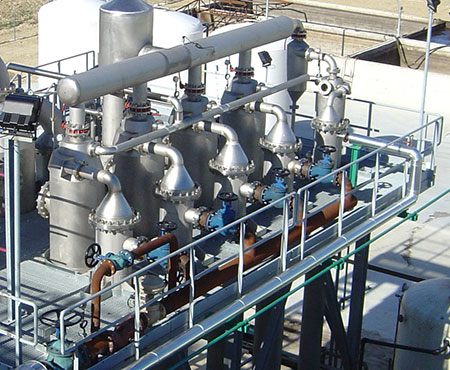
Wastewater and effluent can take many different forms, from relatively clean water, which can safely be discharged to the environment with little or no treatment, to extremely challenging effluent containing high levels of dissolved or suspended solids, chemicals and biological material. Some materials that can be particularly difficult to treat effectively and efficiently include landfill leachate and industrial wastewater streams—many of which can no longer be discharged to the environment or even public sewage systems.
The exact types of treatment used will vary depending on many factors, including the nature of the wastewater or effluent stream(s), the material’s chemical and biological oxygen demand (COD and BOD), the standard required for the final material and whether material capture and reuse are required. However, evaporation is becoming increasingly popular as a way of separating the liquid and solid waste streams.
Examples of Difficult Effluents
Landfill leachate is formed from water that has entered the landfill from external sources (rainfall, surface water and groundwater) as well as the putrefaction of waste materials in the landfill. The composition of landfill leachate will vary with the age of the landfill and the type of waste involved but typically contains both dissolved and suspended materials, such as organic matter (alcohols, acids, sugars, etc.), cations (sulphates, chloride, iron, etc.), heavy metals (lead, nickel, cobalt and mercury) and other complex organic molecules like polychlorinated biphenyls (PCBs) and dioxins. Where large volumes of building waste or gypsum have been disposed, hydrogen sulfide may also be an issue.
Industrial wastewater streams can include heavy metals, halogen compounds and other potentially harmful nutrients or suspended solids. Most countries or regions around the world have strict rules on the treatment and discharge of such waste streams, including requirements for the “zero discharge” of wastewater.
High levels of dissolved or suspended organic materials can also make effluents difficult to treat. A few examples include liquid tannery waste, effluent from fish farms and wastewater streams from abattoirs or even blood-processing laboratories.
Because of this variation in material and treatment, there is also a wide range of treatment techniques that can be used to treat them. Physical separation options include settlement, submerged aeration filters (SAF), dissolved aeration filters (DAF) and induced air flotation. Other biological treatments (aerobic or anaerobic) and chemical treatments (de-salting, alkylation and neutralization) are also often required. However, the use of evaporation technologies to separate difficult effluents into water and solid waste streams (or highly concentrated sludges) is becoming increasingly common.
Zero Liquid Discharge & Evaporation
Zero liquid discharge (ZLD) is a liquid waste stream treatment that involves transforming liquid waste streams into clean water (which can be reused) and a minimum volume of solid residues. It is particularly suitable for effluents that are hazardous, toxic or difficult to treat using other methods. A well-designed ZLD system will minimize or eliminate liquid waste streams, resulting in clean water for reuse or environmentally friendly discharge and a solid residue suitable for further processing (often to recover valuable components for use elsewhere) or safe disposal.
However, separating the water from the effluent requires large amounts of energy. It takes roughly six times more energy to evaporate water (latent heat) at its boiling point than the energy needed to bring it to that boiling point (sensible heat). For this reason, the evaporation processes used for ZLD usually include energy optimization in the form of multistage evaporators, thermal vapor recompression (TVR) or mechanical vapor recompression (MVR).

